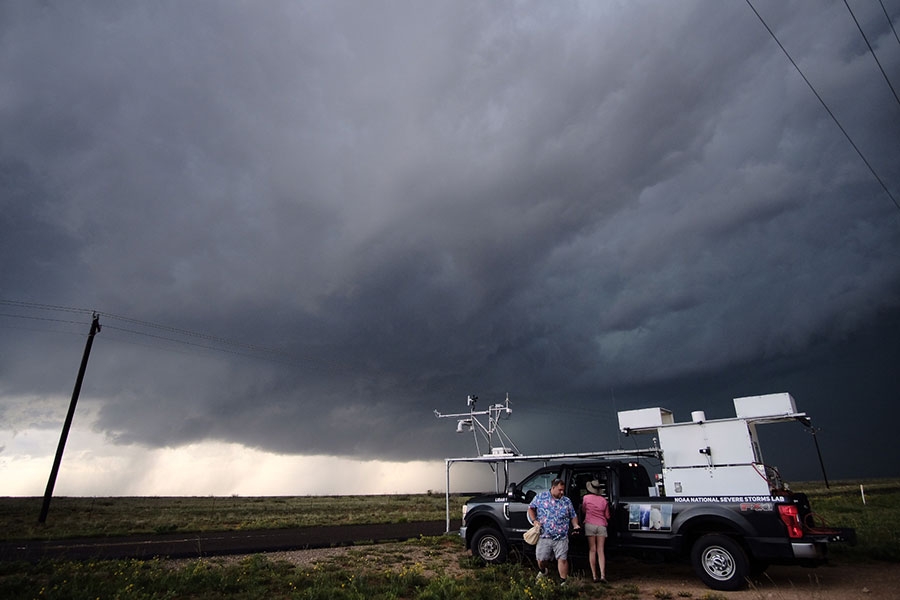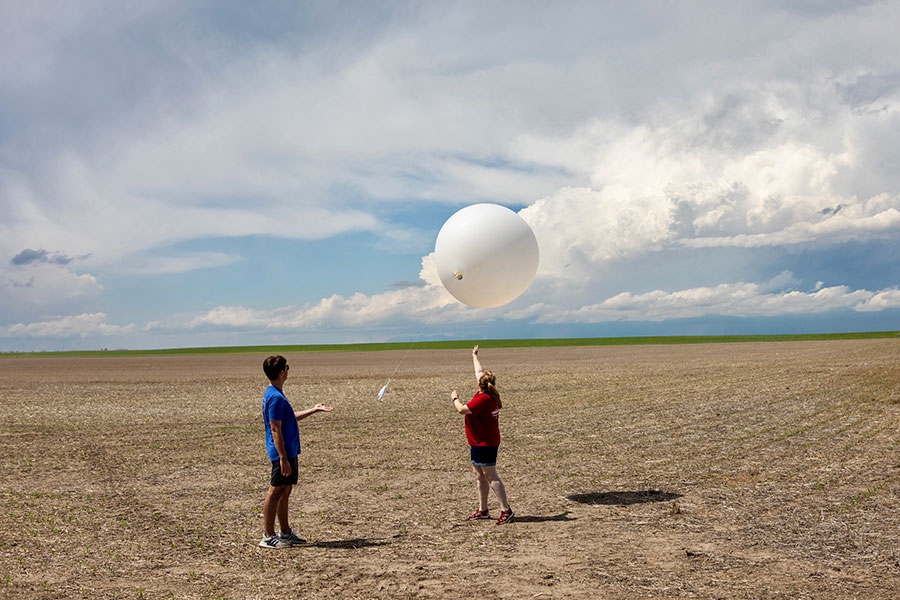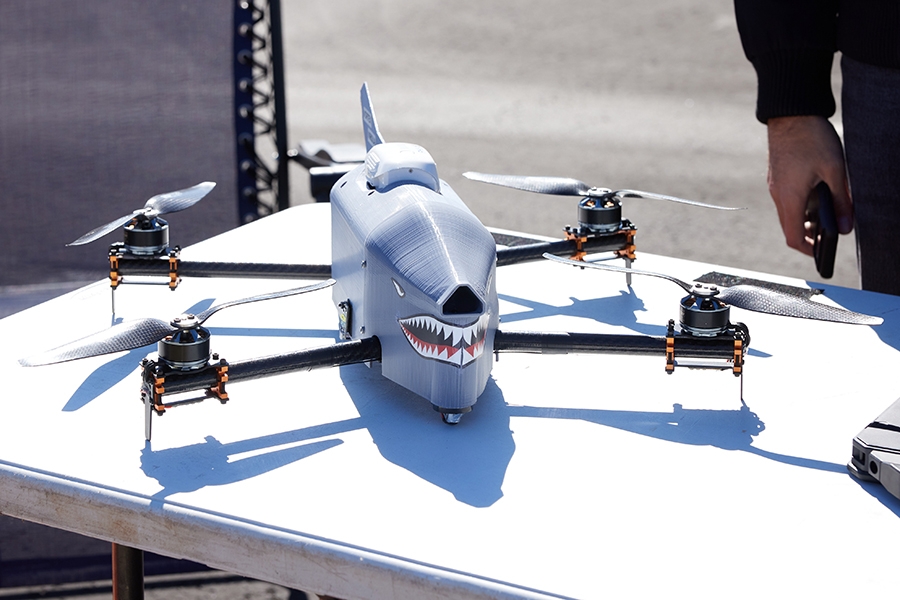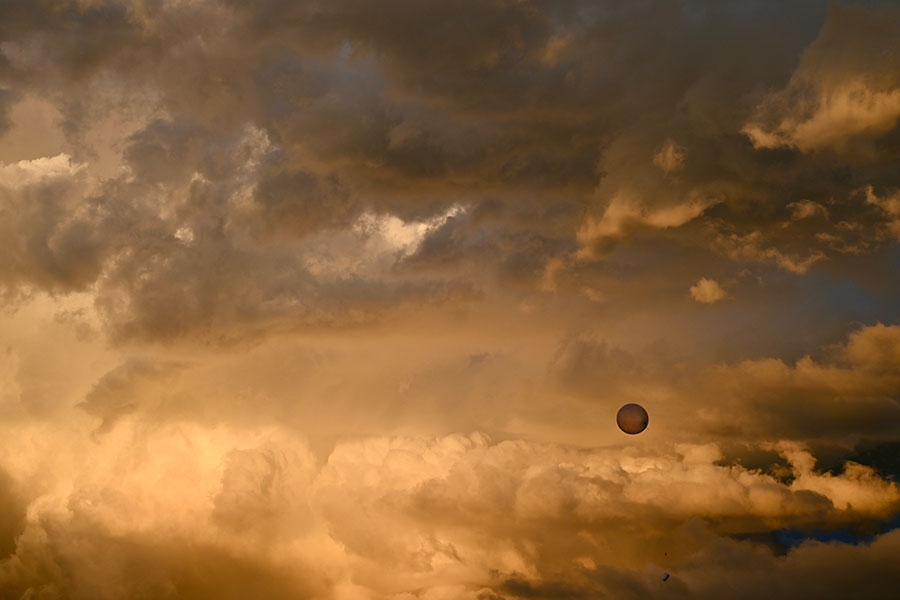
NORMAN, OKLA. – The first time Bobby Saba had to give a weather briefing ahead of a potentional weather event of interest, all the tabs of his internet browser closed as he went to share his screen. He was presenting to the whole fleet of scientists participating in the Propagation, Evolutions, and Rotations in Linear Storms (PERiLS) field project and he had to start from scratch. In retrospect, he calls the experience character building.
Weather briefings are a crucial part of meteorological field work, a process that helps all researchers involved keep up to date on the earth systems creating the weather they hope to sample. Weather briefings are also just one of many ways field work provides out-of-classroom learning experiences for students studying meteorology at the University of Oklahoma.
Despite the technological hiccups, Saba enjoyed the opportunity, which allowed him to immerse himself in the current workings of the atmosphere.

Students in action
Saba studies low-level attributes of tornadic storms, helping operate the NOAA National Severe Storms Laboratory Doppler lidar truck, which collects wind data via laser. He has always been interested in severe storms and describes OU as second-to-none when it comes to research on severe storms. In addition to PERiLS field project, he participated in TORUS (Targeted Observation by Radars and UAS of Supercells) in 2023, and recently finished working on DELTA (Detecting and Evaluating Low-level Tornado Attributes). He is currently participating in the Lower-level Internal Flow of Tornadoes, LIFT, experiment. These projects are funded by NOAA and the National Science Foundation.
Saba is a master’s student in the OU School of Meteorology. He earned his Bachelor of Science in atmospheric sciences/meteorology from Northern Vermont University–Lyndon, a liberal arts college that prepared Saba well for his graduate education but didn’t offer field work experience. Coming to OU has been a life-long dream of his.
OU is also Jordan Tweedie’s dream school, an opportunity she’s been waiting her whole life for. Tweedie is another OU graduate student doing field work this year, participating in OUTFLOW (Oklahoma UAS Targeted Flights for Low-level Observations of Weather), a NOAA-funded project that began operations in early May.
Tweedie is one of a handful of School of Meteorology students who earned a Part 107 license since coming to the university, a certificate from the Federal Aviation Administration necessary for flying drones. Tweedie operates a CopterSonde out in the field, an unmanned aerial system developed by researchers at the OU-NOAA Cooperative Institute for Severe and High-Impact Weather Research and Operations. The CopterSonde is equipped to fly in severe weather to sample the lower atmosphere. Flying it requires a three-person team consisting of a pilot in command, a ground station operator and a visual observer.
After taking the CopterSonde into the field, Tweedie processes the collected data to be assimilated into the Warn on Forecast system — a NOAA project that aims to increase lead time for dangerous weather through a rapidly updating, high-resolution ensemble model system. “Being able to collect that data that I then transcribe and see on a computer and work with, that is a really rewarding process,” she said.
Tweedie said being in the field makes her feel like she is part of the scientific process. Even null days — days when the sampled weather does not meet expectations — she enjoys the opportunity to be part of the scientific enterprise.
“It’s a different feeling, being able to go out in the field. It’s makes everything you do in the office feel a lot more tangible,” Tweedie said. “It helps you really see the importance of why we need to collect these observations.”
Tweedie has first-hand experience with the ‘why’ behind so much of the work happening in the School of Meteorology. The event that sparked her love for meteorology was seeing the destruction wrought by Hurricane Charley in Florida in 2004 and thinking that learning how such storms form could improve disaster responses. Additionally, her first experience in the field was shortly after the March 24-27, 2023 tornado outbreak, which included the Rolling Fork–Silver City tornado that caused 17 deaths and over 150 injuries. She says the damage she witnessed was burned into her mind.
“Seeing the damage first-hand is a great motivator to show that this is important, this is why we need to keep doing this work. It’s humbling and it’s very motivational,” she said.

Beyond the textbook
Cameron Homeyer, Ph.D., interim director of the School of Meteorology, says getting into the field offers students a unique way to appreciate the challenges of the scientific process. “They can start to understand the difficulties that are in front of obtaining these measurements and why the expenses can be quite high for these datasets,” said Homeyer.
Not only does field work expose students to the operational aspect of science, the cross-institution collaboration is also a networking opportunity. More often than not, students going into the field are working with faculty, staff and students from other universities. On top of the scientists from the National Severe Storms Laboratory and CIWRO (both located alongside the School of Meteorology in the National Weather Center), they are collaborating with personnel from other universities and research institutions. The PERiLS project that Saba participated in included personnel from three NOAA laboratories and the NOAA National Weather Service Southern Region, as well as universities in Alabama, Louisiana, Texas, Pennsylvania, New York, Illinois, North Carolina and Indiana
For Saba, that kind of collaboration is a dream come true. Going out into the field for the first time was an exciting chance to step into a project full of scientists working toward the same mission.

Looking toward the future
Upon competition of his master’s program, Saba hopes to stay on at the University of Oklahoma to earn his doctoral degree. His career goal is to return to take his research experience to a small university one day and teach in a program that focuses primarily on undergraduate degrees. “I want to bring research opportunities that I didn’t have to undergraduate students at other schools,” said Saba.
Tweedie defends her master’s thesis in July 2024 and plans to enter the private sector after completing her degree. She hopes to take the knowledge she gained earning an emergency management certificate during her undergraduate education with her to jobs in meteorological data analysis, and possibly emergency and risk management in the future.
“Learning in textbooks is great, it’s really important, but to be able to take what you’re learning in the classroom and to be able to see it happening in real-time is something I cannot even begin to put into words,” said Saba. “I’ve learned so much by just being a part of a field project, and not only going out in the field but just being a part of the conversations.”
Learn more about the School of Meteorology at meteorology.ou.edu.
About the University of Oklahoma
Founded in 1890, the University of Oklahoma is a public research university located in Norman, Oklahoma. As the state’s flagship university, OU serves the educational, cultural, economic and health care needs of the state, region and nation. OU was named the state’s highest-ranking university in U.S. News & World Report’s most recent Best Colleges list. For more information about the university, visit ou.edu.
The Tulsa County Medical Society recently inaugurated Ondria Gleason, M.D., as president for 2025. Gleason is a professor and chair of the Department of Psychiatry at the University of Oklahoma School of Community Medicine and a practicing psychiatrist with OU Health Physicians in Tulsa.
Researchers from the University of Oklahoma have joined the National Endowment for the Humanities Community Deep Mapping Institute and a community-based organization to create a layered history of a community park in Picher, Oklahoma.
Clinical trial results published today in the Journal of the American Medical Association indicate a potential shift in managing bleeding complications after major open-heart surgery.